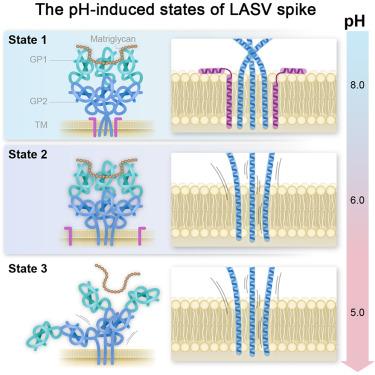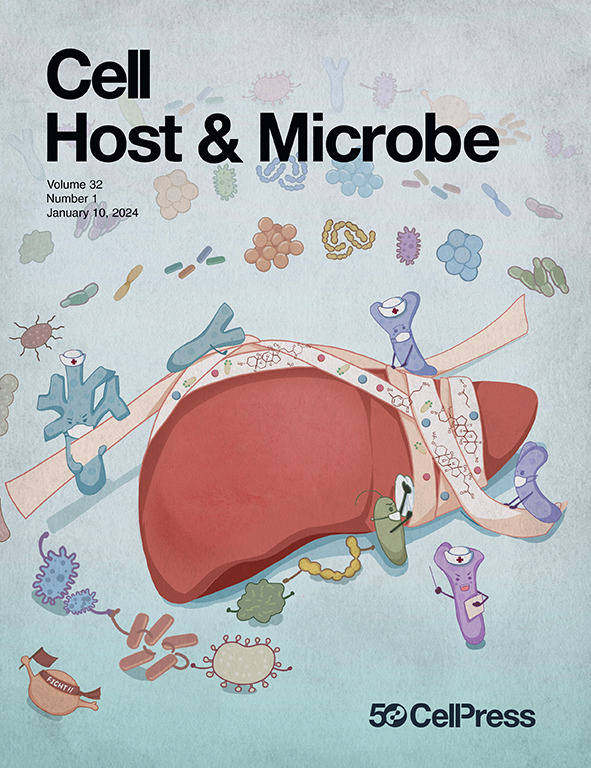ph诱导的拉沙病毒刺突复合体的构象变化和抑制
IF 18.7
1区 医学
Q1 MICROBIOLOGY
引用次数: 0
摘要
拉沙病毒(LASV)是一种毁灭性的人类病原体,没有疫苗和有限的治疗方法。LASV i类刺突复合体通过结合其主要宿主受体基质多糖(matrilycan)与靶细胞结合,然后通过巨噬细胞作用和结合其次级受体溶酶体相关膜蛋白1 (LAMP1)来触发病毒融合。这一过程发生在多个ph依赖的步骤中,但分子事件在很大程度上仍然未知。通过高分辨率结构,我们研究了ph诱导的膜融合前峰的构象变化。我们揭示了ph敏感的金属配位位点,这些配位位点控制着刺突天然状态的完整性,阐明了刺突跨膜区域的重组,并提供了刺突与其主要受体分离的机制。使用进入抑制剂ARN-75039,我们验证了我们的发现,并建立了该研究药物结合和功能的分子基础。这些数据确定了LASV进入细胞的分子基础,并将促进对抗该病毒和可能相关的病毒病原体的努力。本文章由计算机程序翻译,如有差异,请以英文原文为准。

pH-induced conformational changes and inhibition of the Lassa virus spike complex
Lassa virus (LASV) is a devastating human pathogen with no vaccines and limited therapeutics. The LASV class-I spike complex engages target cells via binding its primary host receptor, matriglycan, followed by macropinocytosis and binding of its secondary receptor, lysosomal-associated membrane protein 1 (LAMP1), to trigger virus fusion. This process occurs across multiple pH-dependent steps, but the molecular events remain largely unknown. Through high-resolution structures, we study the pH-induced conformational changes of the spike preceding membrane fusion. We reveal pH-sensitive metal coordination sites that control the integrity of the spike's native state, elucidate a reorganization of the spike's transmembrane region, and provide a mechanism for dissociation from its primary receptor. Using the entry inhibitor ARN-75039, we validate our findings and establish the molecular basis for the binding and function of this investigational drug. These data define the molecular basis for the cell entry of LASV and will promote efforts in combating this virus and potentially related viral pathogens.
求助全文
通过发布文献求助,成功后即可免费获取论文全文。
去求助
来源期刊

Cell host & microbe
生物-微生物学
CiteScore
45.10
自引率
1.70%
发文量
201
审稿时长
4-8 weeks
期刊介绍:
Cell Host & Microbe is a scientific journal that was launched in March 2007. The journal aims to provide a platform for scientists to exchange ideas and concepts related to the study of microbes and their interaction with host organisms at a molecular, cellular, and immune level. It publishes novel findings on a wide range of microorganisms including bacteria, fungi, parasites, and viruses. The journal focuses on the interface between the microbe and its host, whether the host is a vertebrate, invertebrate, or plant, and whether the microbe is pathogenic, non-pathogenic, or commensal. The integrated study of microbes and their interactions with each other, their host, and the cellular environment they inhabit is a unifying theme of the journal. The published work in Cell Host & Microbe is expected to be of exceptional significance within its field and also of interest to researchers in other areas. In addition to primary research articles, the journal features expert analysis, commentary, and reviews on current topics of interest in the field.
 求助内容:
求助内容: 应助结果提醒方式:
应助结果提醒方式:


